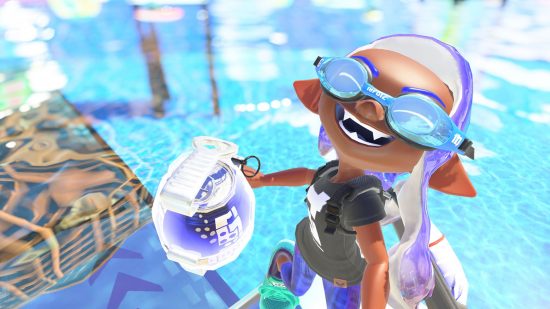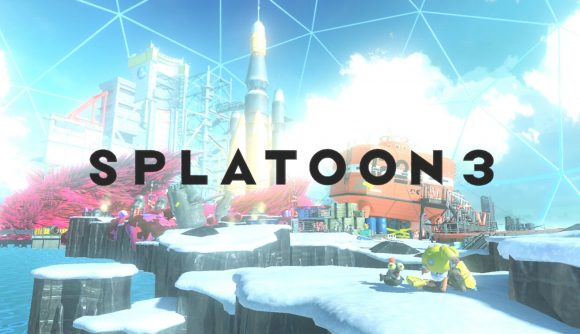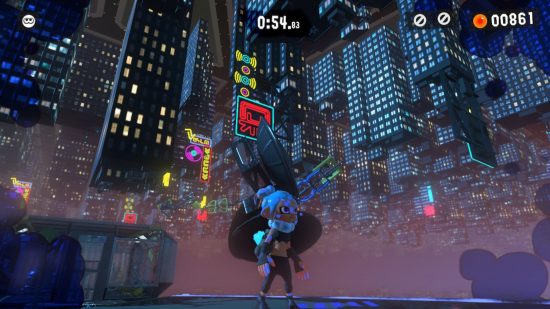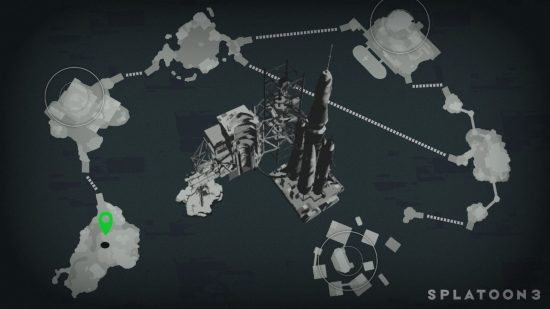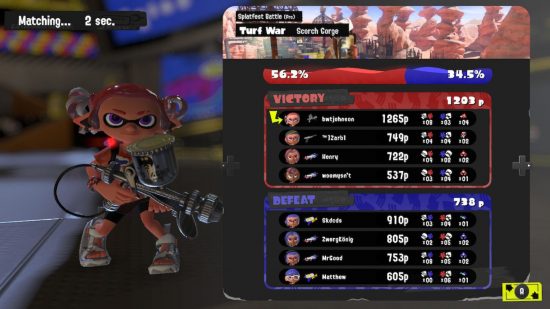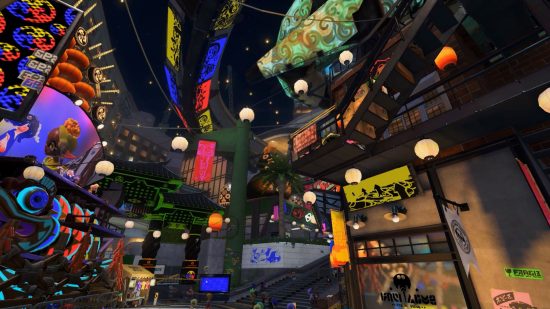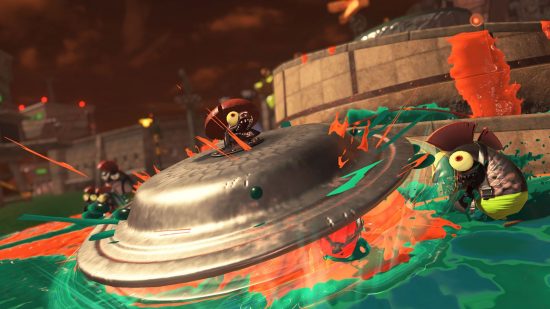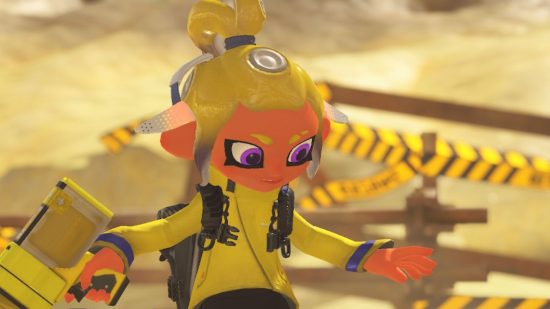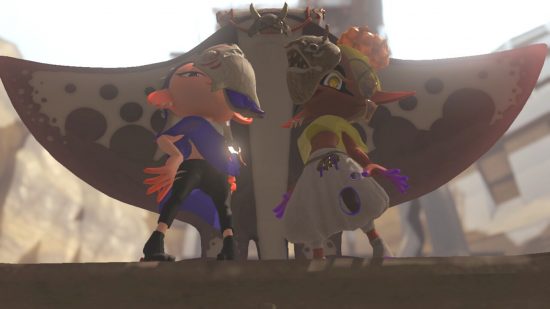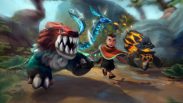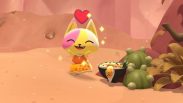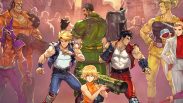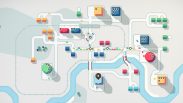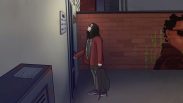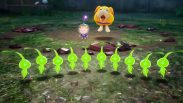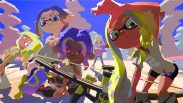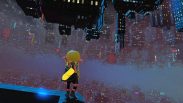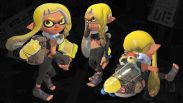Reviewing Splatoon 3 before release is a bit like going to the pub on a Tuesday. It can be a really nice pub, even your favourite if you want, but if it’s really empty you almost feel guilty for being there. You feel bad for doing something like that alone. This makes reviewing Splatoon 3 really quite hard, clinically examining its limbs in their most anaesthetised state. Sure, it’s got some hot muscles, but it’s not going to tense them all that much for me.
Anyway, that’s two metaphors in one paragraph which I think is over the limit set by my doctor (“no, actually doctor, it’s one simile and one metaphor, which is fine right?”). What I’m trying to say is — I reviewed the worst version of this game possible. One without the excellent community that makes the game such a wonderful place to be. Still, I absolutely love almost every single inch of its hot, offline muscles.
This is only one obstacle to understanding a Splatoon sequel. The other is the Overwatch 2 question: why? When a game is spot-on in achieving its aim from the outset, how can a sequel push it forward in a meaningful way? Splatoon 2 answered this question by saying, “hey, I’m on Switch”, which is fair enough. But how does Splatoon 3 answer it?
Well, Splatoon 3 answers it in such a way that a lazier person than me may be close to calling this Splatoon 2.5. But any Splatoon connoisseur, any keen-eyed ink-splatting idiot like myself, can see the tweaks to and the fine-tuning of the great, the sanding-down and the polishing of the good, and the galvanising of the perfect. Splatoon 3 is the realigning of an old keirin wheel.
Far away from Inkopolis are the Splatlands, a large region with a bustling city known as Splatsville. In the desert outskirts sits the Eiffel Tower, upside down, in a monstrous crater. You meet your squid self and head off through the desert to learn the ropes, before hopping on a train into the centre of the dense city. And that’s it. You’re in.
If you’re yet to even have a look at the ropes, let alone learn them, Splatoon works like this: you have a gun that shoots ink, you run around and shoot it; your enemies can shoot a different colour ink; you can swim through your own ink, even up walls splattered with it, but can’t through enemy ink. That’s the basics, at least. Once you’re up to speed, the game tells you to either head to the lobby and get splatting in multiplayer or head down a tunnel some old fella keeps popping out of and staring out from.
You choose to go down the old man’s pipe. Uh oh! This is the single-player mode, Return of the Mammalians. You’re in the world of Alterna, and some story stuff is going on, sure, but that’s not why we’re here, really. We’re here to play a videogame.

The world of Alterna is your overworld map, made up of six islands littered with drains which you can jump down to complete a level. The issue is, Alterna is covered in a load of fuzzy goop-muck. This stuff is a thick, hairy liquid that you can’t touch. To get rid of it you need to throw some power eggs at a large bulbous ball coming out of the hairy stuff. Think all the Ganon muck from Breath of the Wild except this time there’s hair on it and the bulbous bits aren’t eyes (in fact, it works identically to Ganon muck).
So; do challenges, get power eggs, unlock more of the map, and repeat. The addition of the overworld comes with both good and bad things. Sure it’s fun to run around and clear muck up, but there are also collectables scattered around. Grabbing them is cool if you like stuff, but in spite of the hairy muck’s similarity to BotW, the rest of the overworld doesn’t continue that trend.
Rather than guiding your eye towards a collectable, it’s often just hidden under snow. There’s nothing in the world that would make you expect it to be there – some aren’t hidden, mind you, but many are – so to find it you need to get lucky, send out your little buddy to find it, or hop on one of a handful of viewpoints to scan the area, where it will then get highlighted in a blue square.
This doesn’t matter if you hoon it straight through the single-player to see the end. But any completionists could find this excruciating. I did absolutely everything, and it was tiresome. (Still, the game doesn’t really ask you to play it like that, so maybe it’s my fault). This, among a couple of other aspects I can’t talk about, stops the single-player mode from being perfect.
Luckily, these are the only drawbacks. The rest of the overworld is vibrant, scattered with some traversal puzzles, balloon-popping platforming, and a few hidden secrets that aren’t completely unintuitive. It’s a mini, no-pressure playground with some good ideas to keep it interesting.
Almost every single-player level in Splatoon 3 is exquisite, luxurious, masterful, and thrilling when firing on all cylinders. They range from basic weapon-teaching corridors to long, tricky gauntlets and onto mean ability-removing challenges. This isn’t as hard as the Octo Expansion – which is good news for newcomers – but it’s just as finely crafted. (Now I feel bad for starting with my nitpicks – the single-player is great!).
There’s a playfulness in every level, a feeling that a team which knows this game inside out also knows how to break and twist it. It teaches you a lot too, about how to use some new movement mechanics, new weapons, and generally how to be good at the game. It’s reminiscent of Nintendo’s best level-design work on the Switch – it’s interesting how you can hear design echoes of Mario or Zelda in a game so mechanically different – and while it’s not the main event, it’s damn good fun.
The main event is, of course, the multiplayer. Turf War is the classic, easy-to-understand mode that everyone can jump into. The aim is to cover the ground with more of your ink than the enemies. Simple, right? Well, nothing’s changed in terms of how engaging it is, building different tactics to take down enemies to then coat the ground with your ink. Now, though, when you take down all four enemies in quick succession, the word ‘WIPEOUT’ appears on the screen, just to make it feel even better.
Alongside this are Anarchy Battles, a renaming of Splatoon 2’s ranked battles. There’s Splat Zones (keep specific squares of turf your colour to win), Tower Control (ride the tower to the destination), Rainmaker (get the rainmaker to the enemies plinth), and Clam Blitz (collect clams and throw them in the enemy basket). Sound familiar? That’s because it’s all pretty much the same.
So what stops me from calling the multiplayer Splatoon 2.5? Well, there are two things. Firstly, this game has two years of content updates and community events that will fundamentally make it what it is. As I said earlier about anaesthetised limbs, Tuesday pubs, etc… this feels pretty empty pre-release. The multiplayer is so much more exciting when the buzz of the community is there. It may not be here yet, but it’s inevitable.
Secondly, there are new movement abilities that take the multiplayer up a notch into the even-trickier-to-master territory. There’s the squid roll, which lets you leap in a different direction to the one you’re swimming in and get a little bit of invincibility – this is going to be crucial once everyone starts playing – and the squid surge, which lets you launch yourself up an inked wall – this seems a little less useful, but I’m sure that players more intelligent than me will prove that wrong.
These additions change the multiplayer more dramatically than appearances suggest. Sure, the tadpole town of unranked Turf War is still just silly fun, but once higher-rank Anarchy Battles kick off we’re going to see some impressive stuff, I guarantee it. Changing the movement in a game that’s so focused on movement – moreso than most competitive multiplayer games – is a much more dramatic change than is immediately obvious.
There’s also the big warm blanket of quality of life improvements which help make Splatoon 3’s multiplayer feel a lot slicker. Just doing stuff is quicker, like getting into a battle or opening a menu – it’s all a tad smoother, which is ace. You also have automatically-saved replays, an unobtrusive Splatcast, and more opportunities to customise – your character’s clothes, your player tag, a new locker you can fill with junk and show off to friends (I spent about an hour customising mine for some reason) – which just makes not playing the main game a bit more fun.
Another addition is Tableturf Battle – a card-based mini-game where you splat a grid with squares to conquer the map using tetromino-esque shapes based on various things from the world of Splatoon. I spent way too much time playing this. It’s not particularly special, but it’s really good fun and a nice distraction from the full-on mayhem of the multiplayer battles.
It all just adds to the platter of options available, a key element of the game. If you get bored of the lonely single-player, head over to the lobby and do some multiplayer, or if you just want to chill out go shopping and play some cards, there’s always something.
Another something is Salmon Run: Next Wave, the new iteration of Splatoon’s horde mode. Other than the additional movement options, you can also now throw the golden eggs you need to collect to hit your quota, meaning everything zips along at a much faster pace. Salmon Run was never my favourite thing in the world, but Nintendo has definitely improved it. If that’s something you’re looking forward to, it’s better than before, just not my pick of the different modes available.
This smorgasbord is more than enough to fill you up, and it’s all presented with a tad more polish and luxuriousness. Visual differences are harder to pick out, but Splatoon 3 is definitely prettier than its predecessors. Performance is also excellent, which is, of course, vital in a game like this. I had no issues, either in handheld or docked mode, which is good news.
While the real human players may have mostly been lacking in my pre-release experience, the fake community in-game is still loud and ridiculous. The Splatoon 3 soundtrack – made up of various fictional bands that all make different fusions of disparate genres – is absolutely wild. Single-player tracks are filled with bubbly baselines, danceable beats, and vocoded warbles that sound like Daft Punk turned that wackiness knob way too high. The multiplayer brings back classics that stomp louder and harder than ever. And Nintendo has given Salmon Run’s theme a good old dose of horrible, dissonant, unknowable strangeness that leans into its nonsense more than ever. I love this stuff so deeply, so much so that I can’t properly express the giddiness I felt hearing all the different songs. This is the shit.
Side-note: there’s also a lot more influencing the melodies and composition of these songs. There are the same old J-pop, hip-hop, punk, and metal musical references littered throughout, but, as you can see in the Deep Cut tune below, the percussion and instrumentation take a lot from Brazilian music. Think Fabriano Fuzion or Masayoshi Takanaka but Splatoonified, I guess.

So, I’ve palpated Splatoon 3’s quiet limbs and come away with a lot. The surrounding aspects, like quality-of-life improvements, visual fidelity, mini-game, and everything else are excellent. It’s not why you buy the game, but it keeps everything feeling fluid – you’re never stuck for something to do.
The single-player, while arguably the least important aspect of the three main game modes, is as excellent as you’d expect it to be. The feeling it leaves me with is one of excitement, excitement for the promised DLC and what single-player invention will come with it. Return of the Mammalians is so good that all I want is more (and some less annoying aspects in the overworld for us hundred-percenters, please).
When it comes to the multiplayer options, all I can see is the potential – one that far outstrips the previous games’ potential – to build a bigger, stronger, and more dedicated community than ever before. Nintendo has improved the gameplay, sure, but it was already very good. So, what matters to a Splatoon sequel when playing the game is already ace?
A reason to come back, every week, for more Turf War, to climb up the ranks in Anarchy Battles, to post drawings and memes through the letterbox, to share replays on Twitter of your favourite plays, to team up with friends and customise your character and build up your Tabelturf deck and keep coming back – that’s what matters in Splatoon 3. And I have no doubt that it’s all there, even if I haven’t had the chance to see it flourish. I’m certain of it.
For more beyond our Splatoon 3 review, check out our Splatoon 3 weapons, Splatoon 3 idols, and Splatoon 3 hairstyles guide.
Splatoon 3 review
Splatoon 3 will undoubtedly become one of the best multiplayer games out there. But the issue with playing pre-release is you can only spot the potential. It’s inevitable it will flourish, but I wasn’t able to see it in full bloom. Luckily, the single-player is so good it could be worth buying the game for that alone, while the surrounding quality-of-life improvements and various other additions make this easily the best in the series yet.
